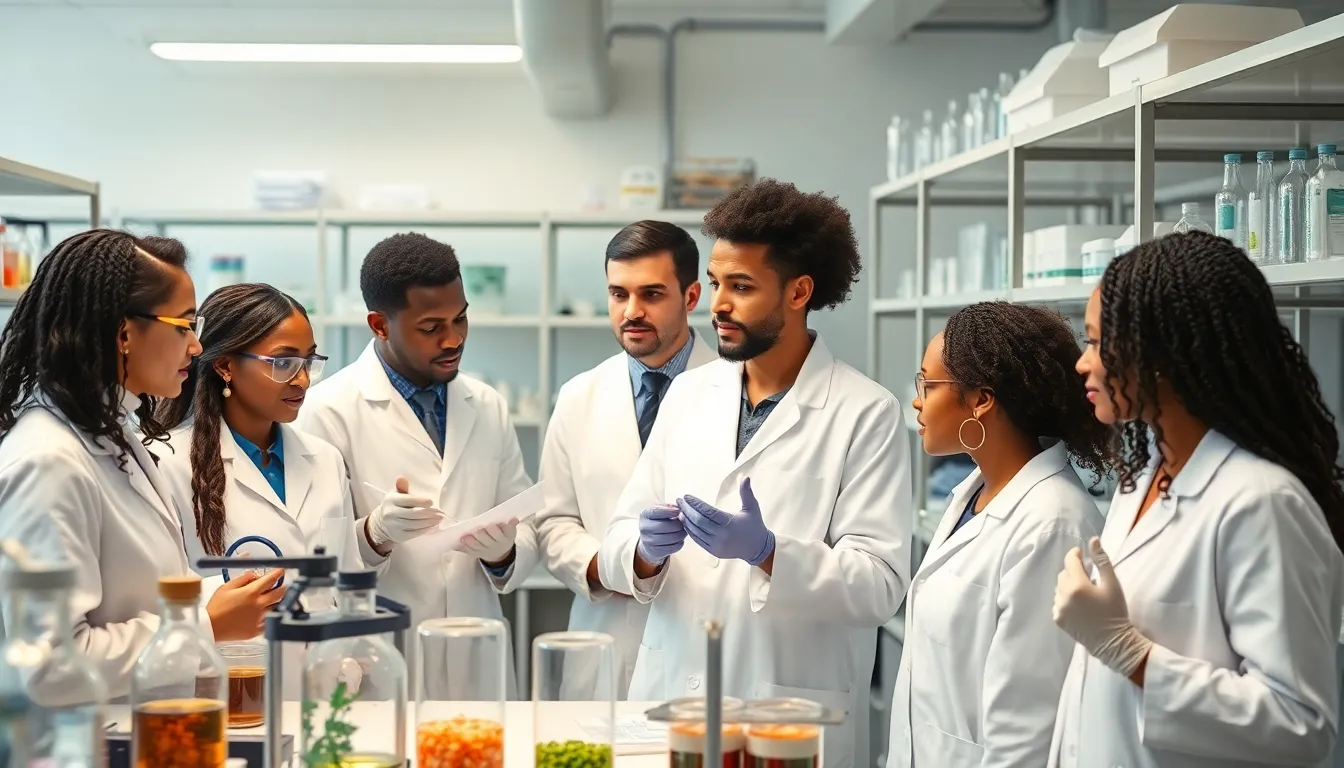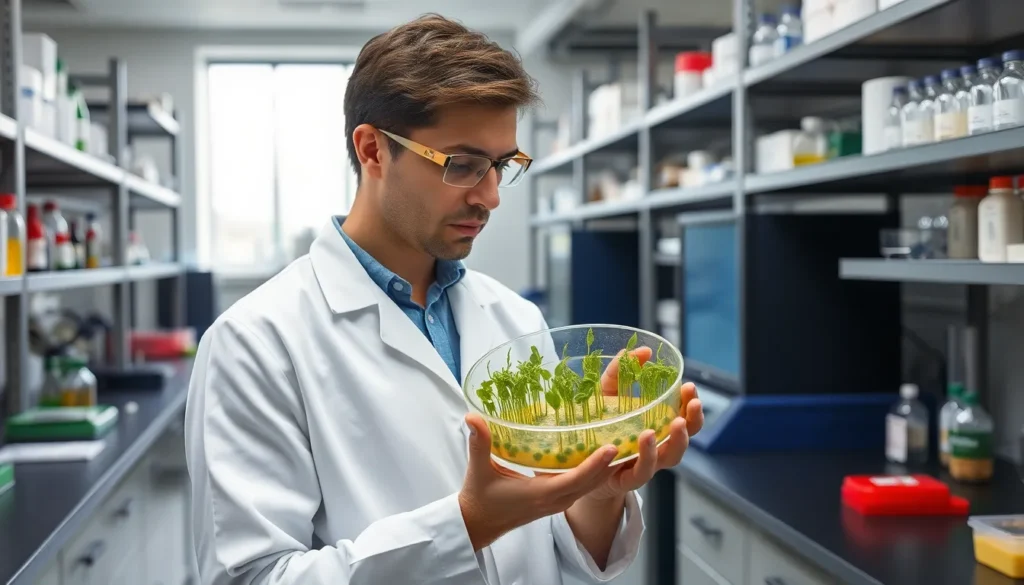Table of Contents
ToggleIn a world where sustainability and technological advancement go hand in hand, bioinnovation stands at the forefront of transforming industries. This dynamic field harnesses the power of biological systems to create innovative solutions, addressing pressing global challenges like food security, healthcare, and environmental sustainability.
From biofuels that reduce carbon footprints to genetically modified crops that withstand climate change, bioinnovation is reshaping how we interact with nature. As researchers and entrepreneurs push the boundaries of science, they unlock new possibilities that promise to enhance lives and protect the planet. Understanding the impact and potential of bioinnovation is essential for anyone interested in the future of technology and sustainability.
Overview of Bioinnovation
Bioinnovation encompasses the application of biological systems, organisms, or derivatives to develop products and technologies that address pressing global issues. Industries leverage bioinnovation to enhance efficiency and sustainability, notably in food production, healthcare, and environmental management.
Biofuels, produced from crops like corn and sugarcane, serve as renewable energy sources, offering alternatives to fossil fuels. Genetically modified crops increase yield and resistance to pests and diseases, contributing to food security. These advancements decrease dependency on chemical pesticides and fertilizers, promoting a more sustainable agricultural practice.
In healthcare, bioinnovation drives the development of pharmaceuticals, vaccines, and personalized medicine. Technologies such as CRISPR enable precise genetic editing, allowing for targeted therapies that treat genetic disorders. These innovations pave the way for improved patient outcomes and cost-effective healthcare solutions.
Environmental sustainability benefits from bioinnovation through bioremediation processes that utilize microorganisms to clean up pollutants. This method reduces soil and water contamination more effectively than traditional approaches. Moreover, bio-packaging materials made from natural resources minimize plastic waste, aligning with environmental conservation goals.
Understanding bioinnovation’s impact fosters awareness of its potential. By recognizing the advancements in biological applications, stakeholders engage in shaping a sustainable future.
Key Areas of Bioinnovation

Bioinnovation significantly impacts various industries, contributing to advancements that address crucial global challenges. The key areas of bioinnovation include agriculture and food production, healthcare and pharmaceuticals, and environmental sustainability.
Agriculture and Food Production
Agriculture and food production leverage bioinnovation to enhance yield and sustainability. Genetic modifications in crops, like Bt cotton and Roundup Ready soybeans, increase resistance to pests and herbicides, respectively. These innovations promote higher food production while minimizing chemical inputs. Additionally, microbial-based fertilizers improve soil health and increase nutrient availability, making food production more efficient. Urban farming solutions, such as vertical farming and hydroponics, optimize space and resource use, further supporting food security in urban environments.
Healthcare and Pharmaceuticals
Healthcare and pharmaceuticals benefit from bioinnovation through the development of novel therapeutics and diagnostics. Technologies like CRISPR and gene therapy enable precise modifications to DNA, offering potential cures for genetic disorders. Immunotherapies, including CAR-T cell therapy, use innovative techniques to harness the body’s immune system against cancer. Furthermore, biopharmaceuticals, produced from biological sources, deliver targeted treatments for various diseases, improving patient outcomes. Personalized medicine advances patient care by tailoring treatments to individual genetic profiles.
Environmental Sustainability
Environmental sustainability integrates bioinnovation to combat ecological challenges. Bioremediation utilizes microorganisms to degrade pollutants in soil and water, effectively cleansing contaminated sites. Innovations in bio-packaging reduce reliance on plastics, employing biodegradable materials that minimize environmental impact. Additionally, the production of biofuels, such as ethanol from agricultural waste, provides renewable energy alternatives, decreasing greenhouse gas emissions. Strategies like circular bioeconomy emphasize resource recycling and waste reduction, fostering a sustainable approach to natural resource management.
Impact of Bioinnovation
Bioinnovation significantly influences various sectors by enhancing productivity and addressing contemporary challenges. Its economic benefits, societal implications, and ethical considerations play crucial roles in shaping future developments.
Economic Benefits
Bioinnovation stimulates economic growth by creating new markets and job opportunities. The global bioeconomy is projected to reach $4 trillion by 2030, driven by advancements in biotechnology and sustainable practices. In agriculture, genetically modified organisms (GMOs) contribute to higher crop yields, reducing production costs. The adoption of microbial fertilizers can reduce chemical fertilizer reliance, resulting in cost savings for farmers. Additionally, investments in biofuels can foster energy independence and create green jobs in renewable energy sectors.
Societal Implications
Bioinnovation addresses pressing societal needs by improving health, food security, and environmental quality. Enhanced crop traits contribute to food availability, easing hunger in developing regions. Personalized medicine approaches, driven by genetic insights, improve health outcomes and empower patients with tailored treatments. Furthermore, sustainable practices in waste management through bioremediation support community health by reducing pollutants, thus enhancing the quality of life.
Ethical Considerations
Ethical considerations surrounding bioinnovation involve ensuring safety, equity, and transparency. Concerns arise from genetic modifications, raising questions about potential environmental impacts and long-term health effects. Regulatory frameworks must balance innovation with precaution, ensuring thorough assessments of new technologies. Equity in access to biotechnological advances remains critical; stakeholders must address disparities to prevent marginalization of communities lacking resources.
Challenges in Bioinnovation
Bioinnovation faces significant challenges that can hinder its growth and implementation. These challenges include regulatory hurdles and public perception issues, both of which impact the pace and effectiveness of bioinnovative solutions.
Regulatory Hurdles
Regulatory frameworks significantly impact bioinnovation, as navigating complex approval processes can delay or restrict advancements. Agencies like the U.S. Environmental Protection Agency (EPA) and the Food and Drug Administration (FDA) regulate genetically modified organisms, which can lead to lengthy review periods. For instance, the approval timeline for genetically engineered crops often spans over a decade, affecting the introduction of beneficial products. Additional challenges arise from varying regulations across countries, complicating international trade and collaboration. Companies must align with distinct regional regulations, risking non-compliance and potential penalties.
Public Perception
Public perception significantly influences the success of bioinnovation. Concerns about safety, environmental impacts, and ethical considerations shape opinions on biotechnological advancements. Many consumers express skepticism towards genetically modified foods, often driven by misinformation and lack of understanding. Surveys indicate that approximately 60% of consumers prefer labeling for genetically engineered products. Strategies to educate and engage the public about the benefits of bioinnovation are essential. Transparent communication that emphasizes safety and efficacy can help shift attitudes. Collaborative initiatives between businesses, researchers, and communities can foster trust and address concerns, leading to broader acceptance of bioinnovative technologies.
Future Trends in Bioinnovation
Bioinnovation is poised for significant growth, driven by emerging technologies and increasing global demand. Key trends shaping the future include advances in synthetic biology, personalized medicine, and sustainable agricultural practices.
- Synthetic Biology
Synthetic biology aims to redesign organisms for specific purposes, enhancing capabilities beyond natural evolution. This field holds promise for creating biofuels, pharmaceuticals, and biodegradable materials. For instance, engineered microbes could produce sustainable biofuels that offset fossil fuel reliance.
- Personalized Medicine
Personalized medicine focuses on tailoring treatments to individual patients based on genetic and biochemical profiles. This trend utilizes genetic sequencing and biotechnology for targeted therapies, offering improved efficacy and minimal side effects. Tools like gene editing and bioprinting are integral to developing customized health solutions.
- Sustainable Agriculture
Sustainable agricultural practices utilize bioinnovation to enhance crop yields and resilience against climate change. Precision agriculture employs sensors and data analytics to optimize resource use. Innovations in soil health, such as microbiome management and bio-based fertilizers, can lead to a more sustainable food system.
- Biomanufacturing
Biomanufacturing leverages biological processes to produce materials and chemicals traditionally derived from fossil fuels. This transition reduces carbon footprints and increases material efficiency. The development of bio-based plastics from renewable resources exemplifies this trend, providing alternatives to petroleum-based products.
- Regenerative Medicine
Regenerative medicine focuses on repairing or replacing damaged tissues and organs using biological materials. Stem cell therapies and tissue engineering are crucial components of this field. Breakthroughs in regenerative techniques promise to treat chronic diseases and improve the quality of life for patients.
- Environmental Remediation
Innovations in environmental remediation utilize biological organisms to address pollution and ecosystem degradation. Techniques like phytoremediation use plants to absorb contaminants while bioremediation employs microorganisms for hazardous waste cleanup. These approaches contribute to environmental sustainability efforts.
- Public Engagement and Education
Engaging the public and educating stakeholders about bioinnovation is vital for societal acceptance. Transparency in biotechnological developments and ethical considerations surrounding their application fosters trust. Open discussions and community involvement will drive the successful integration of these innovations into society.
- Regulatory Evolution
As bioinnovation evolves, regulatory frameworks must adapt to address new challenges and opportunities. Streamlined approval processes can enhance innovation while ensuring safety. Collaborative approaches among scientists, regulators, and communities will be essential for responsible development in the biotechnology sector.
These trends illustrate the dynamic nature of bioinnovation, highlighting its potential to address urgent global challenges and improve quality of life. Continued investment and collaboration across sectors will drive advancements, positioning bioinnovation as a crucial component of future technological solutions.
Bioinnovation stands at the forefront of addressing some of the most pressing challenges of our time. Its ability to enhance food security, improve healthcare, and promote environmental sustainability showcases its transformative potential. As advancements continue to emerge in various sectors, the importance of fostering public trust and adapting regulatory frameworks cannot be overstated.
By embracing bioinnovation responsibly, society can unlock new opportunities for economic growth and improved quality of life. The future promises exciting developments that align with sustainable practices. Engaging stakeholders will be crucial in shaping a landscape where innovation thrives while addressing ethical considerations. The journey of bioinnovation is just beginning, and its impact will resonate for generations to come.







